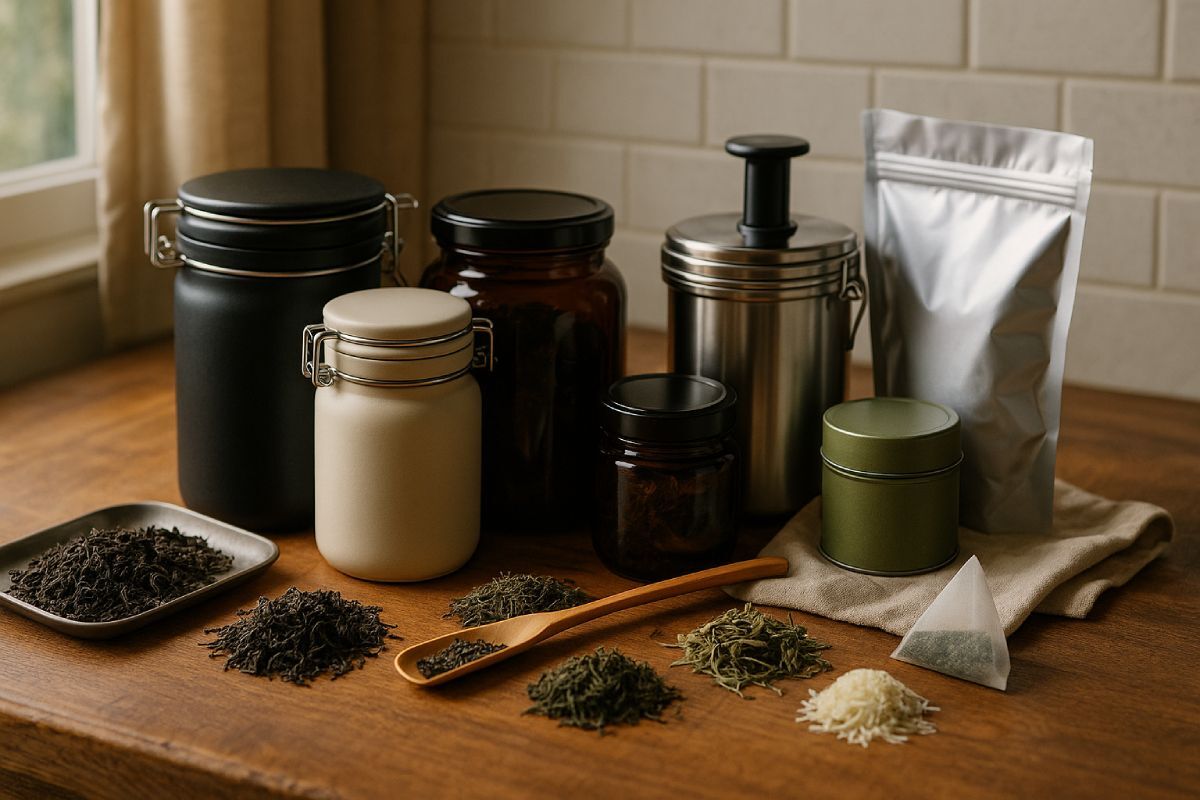
You've selected a beautiful, aromatic tea and brought it home. But how you store it from this moment on will determine whether your future cups are vibrant and flavorful or dull and lifeless. While tea is more stable than coffee, it is still a delicate, dried leaf that can degrade quickly if not protected from the elements.
Proper storage is simple, but it's the key to preserving the quality, maximizing the shelf life, and ensuring every cup you brew is as delicious as the last. This guide will walk you through the essential rules of tea storage, from choosing the right container to understanding the specific needs of different tea types.
The 5 Enemies of Tea Freshness
To keep your tea fresh, you must protect it from five key elements that will rob it of its flavor, aroma, and character.
- Moisture: This is tea's number one enemy. As a dried leaf, tea is highly absorbent (hygroscopic). Any exposure to moisture or humidity will degrade its quality and can even lead to mold.
- Air (Oxygen): Exposure to oxygen causes the delicate essential oils in tea to break down through a process called oxidation. This leads to a rapid loss of flavor and aroma.
- Light: The UV rays in both direct sunlight and artificial light will quickly break down the chemical compounds in tea, causing it to taste flat and stale.
- Heat: Heat acts as an accelerator, speeding up the oxidation process and "cooking" the delicate leaves, which destroys their nuanced flavors.
- Odors: Tea is like a sponge for smells. Storing it next to strong-smelling items like spices, coffee, or garlic will contaminate its flavor profile.
The Golden Rules of Tea Storage
Based on tea's five enemies, here are the simple, effective rules for keeping your tea at its peak.
- Keep It Dry: Always store tea in a place with low humidity. Avoid storing it near a sink, dishwasher, or boiling kettle.
- Use an Airtight Container: A container with a tight-fitting lid is crucial to block out oxygen, moisture, and foreign odors. Fill the container as much as possible to minimize the amount of air trapped inside.
- Store in a Cool, Dark Place: A kitchen cabinet or pantry that is away from the stove, oven, and direct sunlight is the perfect environment for your tea.
- Choose High-Quality Tea: Whole-leaf loose teas have a longer and more stable shelf life than the broken leaves ("fannings" and "dust") found in many standard tea bags.
- Opt for Sealed Wrappers: If you prefer tea bags, choose those that are individually sealed in foil or paper wrappers to protect them until you're ready to brew.
The Best Containers for Storing Tea
Not all containers are created equal. Here’s a breakdown of the best and worst options for tea storage.
- Opaque Tea Tins (Excellent): The classic choice for a reason. Metal or ceramic tins with tight-fitting lids block out light completely and provide an excellent seal against air and moisture.
- Ceramic Jars with a Gasket Seal (Excellent): A fantastic and often beautiful option. The silicone or rubber gasket provides a superior airtight seal. Ensure the ceramic is opaque.
- Dark or Amber Glass Jars (Good): These can work well, but they must be stored in a completely dark cabinet, as they don't block all light. Avoid clear glass jars entirely unless the tea is for short-term display only.
- Foil-Lined, Resealable Pouches (Good): Many high-quality teas are sold in these. They are excellent for storage as long as the seal is robust and you squeeze out all excess air before closing.
- Plastic Bags or Containers (Not Recommended): Avoid standard plastic. It is often porous, may not seal well, and can sometimes impart a plastic-like taste to your tea over time.
Storage Tips & Shelf Life for Different Tea Types
While the storage rules are universal, the expected shelf life can vary by tea type.
| Tea Type | Storage Nuances | Typical Shelf Life |
|---|---|---|
| Green & White Tea | These are the most delicate teas and lose their freshness the fastest. Store them with extra care away from heat. | 6 months to 1 year |
| Oolong Tea | Shelf life varies. Greener oolongs are more delicate, while darker, more oxidized oolongs are more stable. | 1 to 2 years |
| Black Tea | As a fully oxidized tea, it is the most durable and stable type of tea. It holds its flavor well over time. | 2+ years |
| Herbal Tisanes | The potency of flowers (like chamomile) and leaves (like peppermint) can fade. Keep them well-sealed. | 1 to 2 years |
| Pu-erh Tea | This is the exception. Pu-erh is a fermented tea that is meant to be aged. Store it with some airflow, away from odors. | Decades (improves with age) |
Frequently Asked Questions About Storing Tea
What is the absolute best way to store tea?
The best way to store tea is in an opaque, airtight container in a cool, dry, and dark location, such as a pantry or kitchen cabinet. It should be kept away from any strong odors like spices or coffee.
Can tea expire or go bad?
Tea doesn't "go bad" or spoil in a way that makes it unsafe to drink (unless it gets moldy from moisture). However, it does go stale. A stale tea will have lost most of its flavor and aroma and will produce a weak, flat-tasting brew.
Should I store my tea in the refrigerator or freezer?
No. The refrigerator and freezer are generally bad places for tea. The frequent temperature changes create condensation, which is tea's worst enemy. The only exception is for large, vacuum-sealed quantities of certain delicate green teas, but for daily use, this is not recommended.
How long can I keep loose leaf tea?
If stored properly, high-quality loose leaf tea can last for a long time. Green teas are best within a year, while black and oolong teas can last for two years or more. Some teas, like Pu-erh, are aged intentionally and can last for decades.
